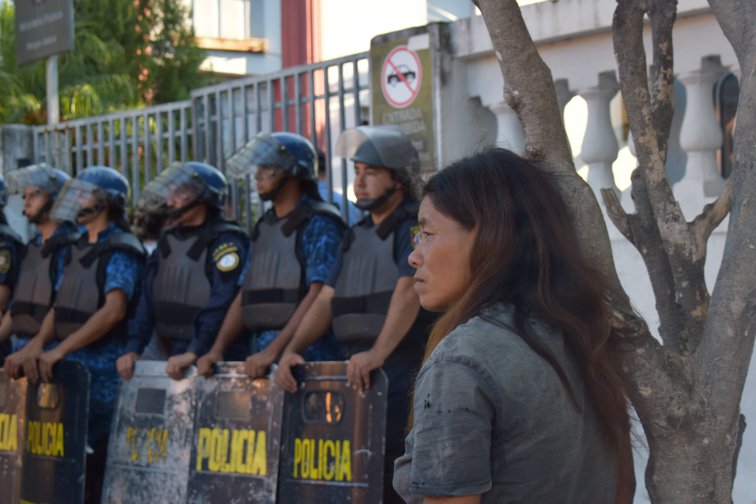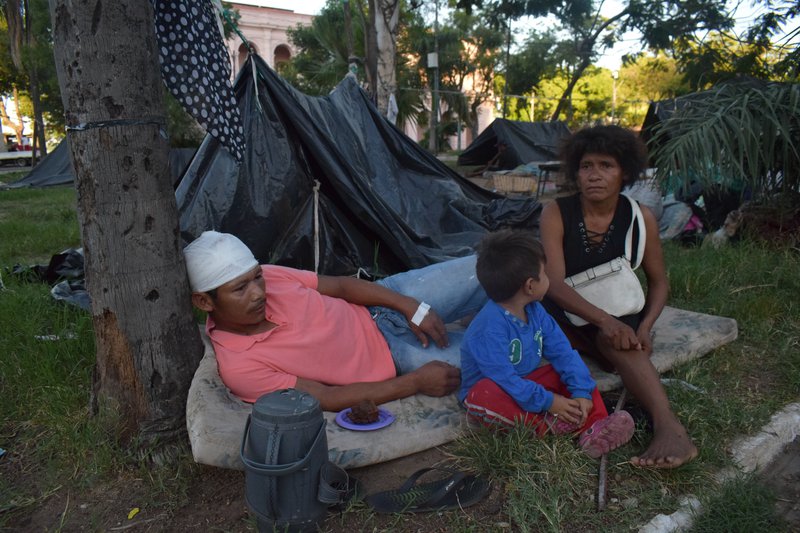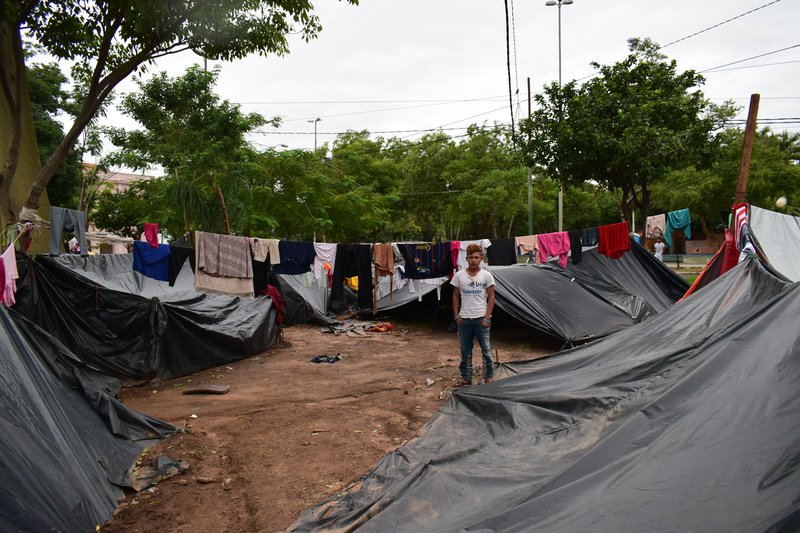Tacuara'i indigenous people facing landlessness in Paraguay


A recently ended six-month occupation of a public square in central Asunción by the Tacuara'i community has brought attention to systemic violations of the land rights of indigenous groups in Paraguay. Español.
We've come to recover our land,' said Vicente Montanía, 'Life is much better there. We had the forest, we had natural meat, fish. We had everything there'. The young indigenous leader was sat in the shade of one of the twenty or so improvised tents fashioned from black tarpaulin and rope that dotted the Plaza de Armas—a large public square in the heart of Asunción, Paraguay's capital.
The scene playing out around him—open fires being tended, barefooted children at play on the paving slabs—had been a constant in this part of the city since an estimated 290 members of the Tacuara'i community had set up camp in the square six months earlier. They had made the 400-kilometre journey to the capital after a violent eviction from what they claim to be their ancestral territory in the east of the country in October 2018. They had come in hope authorities would restore their land to them.
Tacuara'i—a community without a home
'My grandmother died there. So did my mother. And I was born there'.
The 1,000 hectares of ancestral territory claimed by the Tacuara'i community lie in the district of Corpus Christi in the department of Canindeyú, at under a kilometre from the Brazilian border. According to Óscar Ayala, executive secretary of the Paraguayan Human Rights Coordination Group (CODEHUPY), 'There are documents held by the state itself that demonstrate the presence of the Ava Guaraní at Tacuara'i until the beginning of the eighties.'
At that time, which was during the dictatorship, the government forced an arrangement on them that the community was never consulted on and never gave its consent to. They were displaced to other communities. Their claim to receive a title for their lands virtually disappeared and the area became part of the private property of at least two or three businesses'.
Given that during the 1954-89 dictatorship of Alfredo Stroessner 6,744,005 hectares of land were unscrupulously gifted to friends and political allies of the regime, the theft of the lands at Tacuara'i is neither surprising nor unique.
With nowhere else to turn, the indigenous group made the journey to Asunción in search of support from authorities, setting up camp in the Plaza de Armas, which sits within metres of the Legislative Palace
In August 2018, descendants of the expelled families—children and grandchildren—made their way back to Tacuara'i to try to recover the lost territory, now in the hands of Brazilian soya farmers. A series of violent responses followed from the farmers, including the forced disappearance of a young man named Isidoro Barrios; members of the community claim that they saw him tortured and executed.
On 28th October, gunmen stormed the newly re-established settlement, burning possessions and forcing the community out under threats. With nowhere else to turn, the indigenous group made the journey to Asunción in search of support from authorities, setting up camp in the Plaza de Armas, which sits within metres of the Legislative Palace—the building where both the Paraguayan Congress and Senate sit.
This government doesn't want to know
'All the ministers said that this land isn't ancestral, that it's private. But that's a lie'.
For Óscar Ayala, the validity of the Tacuara'i community's claim is undeniable: 'It is absolutely clear that there are numerous pieces of evidence linking the community to that land. From a legal perspective, as the Inter-American Court of Human Rights has established, as long as the community maintains links to a place, the fact that land in question is in the hands of another person does not mean the state is not obliged to handle their claim'.
Paraguayan national law also firmly establishes the right to the communal ownership and use of indigenous territories.
Despite these legal obligations, as well as the continuous attempts by the community to establish a dialogue, the six months spent in the plaza were characterised by silence from the government. As Mirna Rojas, member of a citizens' support network that formed around the indigenous group, mentions, 'They were practically ignored the whole time. They were there in the plaza next to the country's highest authorities and at no point were they given any guarantee related to what they were asking for'.
Ayala explains: 'Whilst Paraguay has a constitution that is relevant to the rights of indigenous peoples, it does not have an adequate legal procedure that indigenous communities like Tacuara'i can use to demand recognition of their territories'.
In spite of specific instructions from the Inter-American Court of Human Rights (ICHR) for the Paraguayan government to address this lack of an adequate procedure, no sign of change has been shown. As a result, communities facing land-related problems are largely left to their fate.

A further sign of governmental negligence towards Paraguay's indigenous population is the chronic underfunding and poor staffing of the National Institute for Indigenous Affairs (INDI)—the institution charged with representing the interests of Paraguay's 116,000 indigenous people (some 2% of the total population).
In relation to the claims of the Tacuara'i community, the president of the INDI, Ana María Allen, stated, 'They are asking for something that it is impossible to give them. They are asking for ancestral lands and that's beyond the INDI'.2 She went further to claim that they are in fact a fraudulent group that do not have any connection to the territory in question.3
In addition to the legal vacuum, no practical support was provided by the INDI during the protest in the plaza. As a result, the community faced hunger and poverty in temperatures approaching 40 °C. Ayala affirms that the lack of any security provision led to the murder of Francisco López, a young indigenous man, on 24th February, in circumstances that are yet to be clarified.
A country governed by the rich for the rich
'He's already planted the soya. That's why he wanted the land, he's a soya farmer'.
A key cause of the Tacuara'i land conflict, as in many others cases, according to the World Bank, is the demand from the mechanised agriculture sector for ever-larger extensions of land for the production of soya and meat (World Bank). The acquisition—both legally and illegally—of enormous amounts of terrain by a small number of groups has left Paraguay with the highest level of inequality of land ownership in the world.
Luis Rojas, a researcher into rural development in Paraguay, states that the government has actively encouraged this concentration of land for industrial agriculture over all other possible usages. He states that low rural taxes, lax environmental laws, high corruption and the personal business interests of politicians greatly favour big landowners. This has led to much tension with other sectors that depend on land ownership, such as indigenous communities, and explains the state’s lack of willingness to engage with groups, like Tacuara’i, presenting complaints.
In relation to land conflicts between the land-owning class and marginalised sectors, Rojas says, 'The law isn't applied according to what the law says, but rather in accordance with who is involved. As a result, the majority of land conflicts are resolved in favour of the big landowner by the legal system'. This has contributed to the creation of a worrying situation in which 145 indigenous communities are facing unresolved land-related problems in Paraguay, according to a UN report.
Rojas says, 'The law isn't applied according to what the law says, but rather in accordance with who is involved. As a result, the majority of land conflicts are resolved in favour of the big landowner by the legal system'
Not even international institutions have been able to impose justice in Paraguay. Three land judgements in favour of indigenous groups in the ICHR have been either not implemented or poorly implemented by the Paraguayan state.
Paraguayan authorities also employ the justice system as a tool to weaken movements. A 2018 Amnesty International report identifies the systematic criminalisation of the leaders of marginalised groups fighting for land ownership. This can be observed in the case of Tacuara'i: a nebulous arrest warrant was deployed to detain Derlis López, one of the principal leaders of the protest.
Allies from the city and the countryside
'Not a single representative has come here. Only the residents of the city have helped us, they've supported us a lot. The government, not at all.'
The Tacuara'i community formed some strong bonds over their time in the Plaza de Armas. They received support from an informal network of city dwellers, who provided food and disseminated information. Furthermore, a wider indigenous movement began to emerge as a number of indigenous groups from across Paraguay added their voices to the Tacuara'i protest both from their own regions and in the capital. However, these connections did not generate sufficient political pressure to force the government to the table.
Julio Benegas, a journalist who has written widely on land conflicts in Paraguay, laments that more support wasn't expressed: 'We didn't realise that Tacuara'i was a symbol of incredible importance. It was an occupation of six months that overcame the bullets of thugs and the deaths of two of their brothers. Why did the popular movement not manage to understand that this was a fight we could win, that we should have won? It could have been the beginning of a symbolic recuperation of our dignity.’
After half a year in the plaza, notable support finally arrived. It came in the form of an alliance with the National Intersectoral Committee (CNI), an organisation of campesinos—peasant farmers—also making their own land-related demands of the government. The campesino sector has also faced intense neglect and exclusion from land ownership in Paraguay and is historically much more numerous and better organised than the indigenous sector.

On 24th March, the alliance of campesinos and indigenous negotiated an agreement with authorities. Regards the indigenous demands, the government committed to begin looking for a solution to the Tacuara'i land conflict. Additionally, it arranged for the community to temporarily stay in another indigenous community—the tents in the plaza were abandoned that evening as the Tacuara'i community was relocated. The protest had come to an end.
Strength in numbers
It’s not just Tacuara’i that has this problem; 90 communities are under threat of eviction. And where can evicted indigenous communities go to?
Benegas is sceptical of the value of this deal: 'They agreed to start a negotiation process. I know how that works: they are long, never-ending negotiations, they don't lead anywhere. It's basically the death of this struggle. That's how this government plays with you.’
The deal does not guarantee the recovery of the Tacuara'i ancestral territory; it shall be seen if, following the indigenous group's long struggle, the state honours its commitment. However, the deal does demonstrate an important point: the government can be forced to negotiate by pressure from well-supported groups.
The experiences of Tacuara’i have demonstrated it: only through strong collective pressure will the institutionalised system of discrimination and neglect that robs indigenous peoples of lands and rights be deconstructed.
Given this, there is a need to construct a better support structure for land conflicts involving indigenous peoples; a powerful support structure that can achieve quick and effective results from its interactions with the state. The participation of an array of sectors is necessary: rural organisations, the urban population, NGOs (whose relative absence was noted by the Tacuara'i community) and the international community.
The experiences of Tacuara’i have demonstrated the following: only through strong collective pressure will individual cases be won and the institutionalised system of discrimination and neglect that robs indigenous peoples of lands and rights be deconstructed.

Source
Language of the news reported
Copyright © Source (mentioned above). All rights reserved. The Land Portal distributes materials without the copyright owner’s permission based on the “fair use” doctrine of copyright, meaning that we post news articles for non-commercial, informative purposes. If you are the owner of the article or report and would like it to be removed, please contact us at hello@landportal.info and we will remove the posting immediately.
Various news items related to land governance are posted on the Land Portal every day by the Land Portal users, from various sources, such as news organizations and other institutions and individuals, representing a diversity of positions on every topic. The copyright lies with the source of the article; the Land Portal Foundation does not have the legal right to edit or correct the article, nor does the Foundation endorse its content. To make corrections or ask for permission to republish or other authorized use of this material, please contact the copyright holder.
